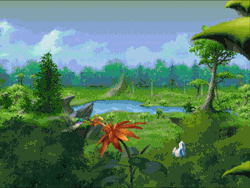 Since the author’s passing earlier this year, I’ve been rereading various books by Terry Pratchett. Currently, I am reading through Small Gods, one of my favorite novels, and one I recommend highly to anyone within earshot. Small Gods is the story of the stupidest genius imaginable, his deeply malicious and power-hungry superior, and a cyclopean turtle that just happens to be a god. I’m sorry, when I describe it that way, only the most “whacky” of my audience pays attention. Er-hem. Small Gods is a farcical look at philosophy and religion and the people that have practiced and “ruled” it throughout the past and present, with a particular eye on the value of worshipping beliefs vs. worshipping tradition. Yes, it is a “funny” book, but it has very serious statements about our society and the way we live our lives.
Since the author’s passing earlier this year, I’ve been rereading various books by Terry Pratchett. Currently, I am reading through Small Gods, one of my favorite novels, and one I recommend highly to anyone within earshot. Small Gods is the story of the stupidest genius imaginable, his deeply malicious and power-hungry superior, and a cyclopean turtle that just happens to be a god. I’m sorry, when I describe it that way, only the most “whacky” of my audience pays attention. Er-hem. Small Gods is a farcical look at philosophy and religion and the people that have practiced and “ruled” it throughout the past and present, with a particular eye on the value of worshipping beliefs vs. worshipping tradition. Yes, it is a “funny” book, but it has very serious statements about our society and the way we live our lives.
Kolibri, the videogame I have played most recently, is the story of a hummingbird repelling an Earth-threatening virus.
That’s… it.
Kolibri is a beautiful and fun game. The graphics are pretty amazing, using the capability of the 32X to create stellar backgrounds and lifelike birds, bugs, and the occasional homicidal toad. The early, “realistic” stages in particular look like some kind of gorgeous watercolor brought to (relative) life. The later, more abstract levels that take place within ancient ruins or murky, goo encrusted caves are much less down-to-earth, but still showcase an attention to detail and art that is often overlooked in much game design of the era. Even today, it’s a rarity to see a game as striking as Kolibri.
But it’s still just a game about a hummingbird.
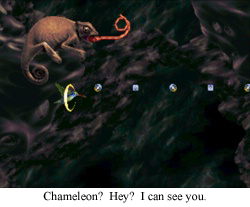 Kolibri’s gameplay is a tight, fast-paced pinnacle of the shooting genre that can be difficult, but with a little practice, becomes something magnificent. Kolibri is a hummingbird endowed with power from the Earth itself, so Kolibri has the ability to shoot various beams and bullets for an R-Type-style offense. All of the weapon options may be tested right at the start, from homing bullets to lasers to a blast that starts small and then explodes into a hail of firepower. Powerups are distributed liberally, so you’ll have plenty of opportunities to switch your loadout around as long as you keep the pressure on the invading bug army. Kolibri can only take a few hits, though, and we’re running off of Mario rules, so if you die, you’re respawning with 1 HP until you find a mushroom… err… life orb to bulk up your defenses. Considering most shooter games only ever offer a single hit of damage per life, this is surprisingly generous in the early stages, and, well, let’s just say the challenge level of Ecco the Dolphin wasn’t forgotten by the designers.
Kolibri’s gameplay is a tight, fast-paced pinnacle of the shooting genre that can be difficult, but with a little practice, becomes something magnificent. Kolibri is a hummingbird endowed with power from the Earth itself, so Kolibri has the ability to shoot various beams and bullets for an R-Type-style offense. All of the weapon options may be tested right at the start, from homing bullets to lasers to a blast that starts small and then explodes into a hail of firepower. Powerups are distributed liberally, so you’ll have plenty of opportunities to switch your loadout around as long as you keep the pressure on the invading bug army. Kolibri can only take a few hits, though, and we’re running off of Mario rules, so if you die, you’re respawning with 1 HP until you find a mushroom… err… life orb to bulk up your defenses. Considering most shooter games only ever offer a single hit of damage per life, this is surprisingly generous in the early stages, and, well, let’s just say the challenge level of Ecco the Dolphin wasn’t forgotten by the designers.
But it’s still just a game about a hummingbird.
Kolibri is even two players! So two hummingbirds can join together to swoop through the sky and battle the forces of evil. At a time well before the advent of four-player Mario or even simultaneous Otomodeus action, Kolibri was there so you could take a break from all those competitive fighting games and work together in a “nonviolent” hummingbird’s playground. No ripping out your neighbor’s spinal column here, just good ol’ fashioned cooperative play as one of nature’s prettiest creatures.
But it’s still just a game about a hummingbird.
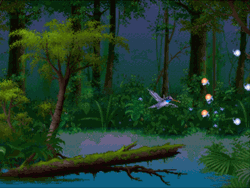 Oh, knock off the refrain. The game is about a hummingbird saving the planet, excuse me, Mother Earth from a malevolent, infectious force. Kolibri is a hummingbird chosen by the very spirit of our planet for the necessary task of saving every one of us. It’s epic!
Oh, knock off the refrain. The game is about a hummingbird saving the planet, excuse me, Mother Earth from a malevolent, infectious force. Kolibri is a hummingbird chosen by the very spirit of our planet for the necessary task of saving every one of us. It’s epic!
So it’s the same plot as Space Invaders.
Well… yeah.
You know what? Final Fantasy 7 had to happen.
As I’ve been elucidating here, Kolibri is a great video game. Its graphics are top notch, its gameplay is fun and exciting, and even the little touches sprinkled here and there make for a memorable game. But it’s really not about anything. A hummingbird, one of nature’s most weak and easily swallowed creatures, repelling an alien invasion in defense of Earth is an interesting, unique notion; but beyond inspiring an appealing art direction, there’s nothing noteworthy about the concept in actual gameplay. This is a game about a hummingbird, and that’s all it can ever be. Were you to divorce this game from any nostalgic memories of the 32X era (which I’m sure isn’t difficult for many of you that may be reading about this game for the first time), all you’re left with is a game that, today, might pass only as an interesting “first effort” from a game developer, and, more than likely, would just be a forgotten title that occasionally popped up in a humble bundle sale that assigned it a value of about 65¢. At the time of its release, though, Kolibri was metaphorically banded together with Knuckles’ Chaotix as the entire reason to own a shiny, new video game system.
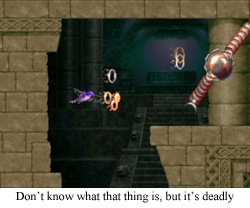 Why was the 32X a failure? Why did the Playstation succeed? There’s a myriad of reasons, but I feel like an often overlooked reason is that, simply, graphics grew more realistic, so stories had to grow, too. As I type this, to my immediate right happens to be my PS2 game collection, a tower of games that is taller than some women I’ve dated (it… was something that was noted). I look at the games that are neatly organized by genre, the action genre is what has caught my eye this night, and try to find a single game that has a plot as razor thin as Kolibri. Maximo is no simple knight rescuing a princess, no, he’s made a deal with Death to battle an usurper king and rescue a harem of maidens before his hourglass ticks down to its last particle. God of War is often decried as some macho violent fantasy, but it’s also the story of a grieving father and widower who seeks suicide by god. The list could go on (as it stares back at me, see also my article on Contra Shattered Soldier), but one thing is clear: even the dumbest, most base of action games now comes complete with a story about something.
Why was the 32X a failure? Why did the Playstation succeed? There’s a myriad of reasons, but I feel like an often overlooked reason is that, simply, graphics grew more realistic, so stories had to grow, too. As I type this, to my immediate right happens to be my PS2 game collection, a tower of games that is taller than some women I’ve dated (it… was something that was noted). I look at the games that are neatly organized by genre, the action genre is what has caught my eye this night, and try to find a single game that has a plot as razor thin as Kolibri. Maximo is no simple knight rescuing a princess, no, he’s made a deal with Death to battle an usurper king and rescue a harem of maidens before his hourglass ticks down to its last particle. God of War is often decried as some macho violent fantasy, but it’s also the story of a grieving father and widower who seeks suicide by god. The list could go on (as it stares back at me, see also my article on Contra Shattered Soldier), but one thing is clear: even the dumbest, most base of action games now comes complete with a story about something.
Final Fantasy 7 was, in my memory, the turning point. Final Fantasy 7 was an unprecedented success (I’ll remind you that it was Final Fantasy Seven, as in, there were a whole host of Final Fantasy games and spin-offs released beforehand that had nowhere near the same level of acclaim) and, like any time there’s a runaway success in the video game industry, every other publisher made a mad dash to replicate whatever made Final Fantasy 7 so damn Final Fantasy 7. “RPG Elements” became a bullet point that is still seen to this day, but, on a more subtle level, every game outside of Mario started bleeding more dialogue than your high school drama club. The story revolution had been gradually sneaking into games for a while (Remember how amazing it was the first time you heard Star Fox talk? Remember how amazing it was that he had anything to say at all?), but now it became all but required, even in games that had no business showcasing their plot, like the entire Mortal Kombat franchise. Never open your mouth again, Sub-Zero! It doesn’t end well!
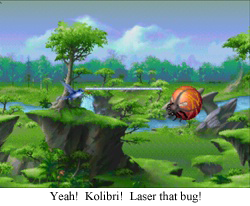 I’ll admit, the whole “story” thing has grown to unsustainable proportions in some games and genres. Assuming ROB ever tosses it into my sights, the comparison between the “short and sweet” plot of Final Fantasy Adventure versus the unending word vomit of its remake, Sword of Mana, could be the subject of an entire article. On this very site, there’s a FAQ that is getting articles in the double digits just trying to explain what the hell happened between a boy, a mouse, and a body snatching old man with thirteen different forms. It could be pretty straightforward, but, no, there’s a big damn story there that exists only to manufacture a reason to pal around with Winnie the Pooh.
I’ll admit, the whole “story” thing has grown to unsustainable proportions in some games and genres. Assuming ROB ever tosses it into my sights, the comparison between the “short and sweet” plot of Final Fantasy Adventure versus the unending word vomit of its remake, Sword of Mana, could be the subject of an entire article. On this very site, there’s a FAQ that is getting articles in the double digits just trying to explain what the hell happened between a boy, a mouse, and a body snatching old man with thirteen different forms. It could be pretty straightforward, but, no, there’s a big damn story there that exists only to manufacture a reason to pal around with Winnie the Pooh.
But we need stories. We need narratives, and as gaming grew more advanced, we needed something more advanced than “murder that turtle” or “shoot that bug”. Kolibri missed that memo, and is just a game about a hummingbird, and that’s all it ever will be.
FGC #41 Kolibri
- System: Sega 32X, and one of the forty games that were ever for that system, like Primal Rage, Night Trap, and Golf Magazine: 36 Great Holes Starring Fred Couples.
- Who the hell is Fred Couples? I don’t know, but it bothers me that he has a game with his name on it, while Ghandi does not.
- Number of players: 2 cooperative hummingbirds. Note that the game’s box says only one player, because… no one cared about the 32X?
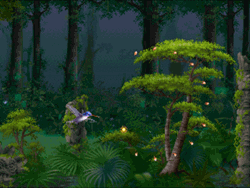 Favorite Weapon: That thing that shoots forward and then explodes. Do these things have names? To the manual!
Favorite Weapon: That thing that shoots forward and then explodes. Do these things have names? To the manual!- Well? Nope. But, oh man, this manual has a guide on how to make a hummingbird feeder. And fun facts about hummingbirds! It says here that “Hummingbirds are nature’s fighter jets”. Wow! I want a hummingbird in my life right now. Wait, the next page says that what I’m talking about is likely the “Cluster Bomb”. Why did they have the manual break for hummingbird facts before getting back to the actual gameplay? How odd.
- Did you know? The manual also has a little drawn Kolibri in the bottom right of each page spread, so if you flip through it fast enough, it’s a little animated Kolibri! Super wow! The manual is only a scant 21 pages, though, so good luck using your thumbs that effectively.
- Would I play again? Maybe, if it didn’t sound like my 32X was going to explode every time I fired it up. I might give Kolibri another go on a Virtual Console or alike service, but only after a sale puts it at five bucks or lower. It’s a fun way to spend an hour, but almost instantly forgettable.
What’s next? Random ROB has chosen… Toejam & Earl. Jammin’! Please look forward to it!

Arguably, the finest hummingbird based shooter for the 32X.
[…] in the Kolibri article, I mentioned that there’s a sort of “uncanny valley” that is unique to video games that, as […]
[…] or even a contemptible ewok. Actually, this kinda falls into the same hole as its 32X brother, Kolibri: it’s a fun enough game, but it feels wildly limited, like an early Nintendo game tried to play […]
[…] little in the world of gaming that gets my attention anymore. I have flown through the skies as the majestic hummingbird, danced with the deities, and one time I got a kangaroo to punch a monkey. And, through it all, […]
[…] belongs to the space shmup genre, and the record will show that I enjoy that genre very much. Now. Back then, however, Gradius was practically my […]